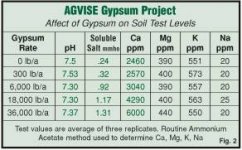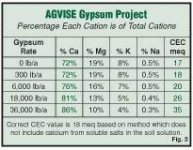B
BrnCow
Linda Chalker-Scott, Ph.D., Extension Horticulturist and Associate Professor, Puyallup Research and Extension Center, Washington State University
The Myth of Gypsum Magic
“Adding gypsum to your yard or garden will improve soil tilth and plant health”
The Myth
Upon continued prodding from one of my university extension colleagues, I recently watched several
episodes of a well-known gardening program on television. My kids joined me, alerted by my animated
responses to the host’s non-stop torrent of advice. Among many amazing discoveries I learned that by
adding gypsum to my yard or garden I would improve my problem soils by changing the particle size and
loosening compaction. Further searching on the web revealed that gypsum would also improve drainage,
decrease acidity, and eliminate soil salts. Previously, I had heard of gypsum for use in soil reclamation
projects, but not for a typical urban landscape. Since gypsum is simply calcium sulfate, could this
chemical truly transform soil structure and serve as a fertilizer for yards and gardens?
The Reality
This myth falls into the category of agricultural practices misapplied to ornamental landscapes.
Gypsum effectively changes the structure and fertility of heavy clay soils, especially those that are heavily
weathered or subject to intensive crop production. Gypsum also improves sodic (saline) soils by
removing sodium from the soil and replacing it with calcium. Therefore, one can see improvement in
clay soil structure and fertility, and desalinization of sodium-rich soils, by using gypsum.
What other effects will gypsum have on soil and plant health? There are a number of scientific studies
on gypsum usage both in the literature and on websites. Briefly, researchers have found:
• Gypsum does not usually change soil acidity, though occasional reports of both increasing and
decreasing pH exist;
• Gypsum can increase leaching of aluminum, which can detoxify soils but also contaminates
nearby watersheds;
• Gypsum can increase leaching of iron and manganese, leading to deficiencies of these nutrients;
• Gypsum applied to acid soils can induce magnesium deficiency in plants on site;
• Gypsum applied to sandy soils can depress phosphorus, copper and zinc transport;
• Gypsum can have negative effects on mycorrhizal inoculation of roots, which may account for
several reports of negative effects of gypsum on tree seedling establishment and survival;
• Gypsum is variable in its effects on mature trees;
• Gypsum will not improve fertility of acid or sandy soils;
• Gypsum will not improve water holding capacity of sandy soils; and
• Gypsum’s effects are short-lived (often a matter of months)
With the exception of arid and coastal regions (where soil salts are high) and the southeastern United
States (where heavy clay soils are common), gypsum amendment is just not necessary in non-agricultural
areas. Urban soils are generally amalgamations of subsoils, native and non-native topsoils, and – in home
landscapes – high levels of organic and non-organic chemical additives. They are also heavily compacted
and layered (and gypsum does not work well on layered soils). In such landscapes, it is pointless to add
yet more chemicals in the form of gypsum unless you need to increase soil calcium levels. This nutrient
deficiency can be quickly identified by any soil testing laboratory for less than a bag of gypsum costs. (If
you need to improve sulfur nutrition, it’s wiser to use ammonium sulfate). To reduce compaction and
improve aeration in nearly any landscape, application of an organic mulch is more economically and
environmentally sustainable.
The Bottom Line
• Gypsum can improve heavy clay soil structure and remove sodium from saline soils
• Gypsum has no effect on soil fertility, structure, or pH of any other soil type
• Most urban soils are not improved by additional gypsum
• Before adding gypsum or any chemical to a landscape, have soil analysis performed to identify
mineral deficiencies, toxicities, and soil character
• Adding gypsum to sandy or non-sodic soils is a waste of money, natural resources, and can have
negative impacts on plant, soil, and ecosystem health
For more information, please visit Dr. Chalker-Scott’s web page at http://www.theinformedgardener.com.
The Myth of Gypsum Magic
“Adding gypsum to your yard or garden will improve soil tilth and plant health”
The Myth
Upon continued prodding from one of my university extension colleagues, I recently watched several
episodes of a well-known gardening program on television. My kids joined me, alerted by my animated
responses to the host’s non-stop torrent of advice. Among many amazing discoveries I learned that by
adding gypsum to my yard or garden I would improve my problem soils by changing the particle size and
loosening compaction. Further searching on the web revealed that gypsum would also improve drainage,
decrease acidity, and eliminate soil salts. Previously, I had heard of gypsum for use in soil reclamation
projects, but not for a typical urban landscape. Since gypsum is simply calcium sulfate, could this
chemical truly transform soil structure and serve as a fertilizer for yards and gardens?
The Reality
This myth falls into the category of agricultural practices misapplied to ornamental landscapes.
Gypsum effectively changes the structure and fertility of heavy clay soils, especially those that are heavily
weathered or subject to intensive crop production. Gypsum also improves sodic (saline) soils by
removing sodium from the soil and replacing it with calcium. Therefore, one can see improvement in
clay soil structure and fertility, and desalinization of sodium-rich soils, by using gypsum.
What other effects will gypsum have on soil and plant health? There are a number of scientific studies
on gypsum usage both in the literature and on websites. Briefly, researchers have found:
• Gypsum does not usually change soil acidity, though occasional reports of both increasing and
decreasing pH exist;
• Gypsum can increase leaching of aluminum, which can detoxify soils but also contaminates
nearby watersheds;
• Gypsum can increase leaching of iron and manganese, leading to deficiencies of these nutrients;
• Gypsum applied to acid soils can induce magnesium deficiency in plants on site;
• Gypsum applied to sandy soils can depress phosphorus, copper and zinc transport;
• Gypsum can have negative effects on mycorrhizal inoculation of roots, which may account for
several reports of negative effects of gypsum on tree seedling establishment and survival;
• Gypsum is variable in its effects on mature trees;
• Gypsum will not improve fertility of acid or sandy soils;
• Gypsum will not improve water holding capacity of sandy soils; and
• Gypsum’s effects are short-lived (often a matter of months)
With the exception of arid and coastal regions (where soil salts are high) and the southeastern United
States (where heavy clay soils are common), gypsum amendment is just not necessary in non-agricultural
areas. Urban soils are generally amalgamations of subsoils, native and non-native topsoils, and – in home
landscapes – high levels of organic and non-organic chemical additives. They are also heavily compacted
and layered (and gypsum does not work well on layered soils). In such landscapes, it is pointless to add
yet more chemicals in the form of gypsum unless you need to increase soil calcium levels. This nutrient
deficiency can be quickly identified by any soil testing laboratory for less than a bag of gypsum costs. (If
you need to improve sulfur nutrition, it’s wiser to use ammonium sulfate). To reduce compaction and
improve aeration in nearly any landscape, application of an organic mulch is more economically and
environmentally sustainable.
The Bottom Line
• Gypsum can improve heavy clay soil structure and remove sodium from saline soils
• Gypsum has no effect on soil fertility, structure, or pH of any other soil type
• Most urban soils are not improved by additional gypsum
• Before adding gypsum or any chemical to a landscape, have soil analysis performed to identify
mineral deficiencies, toxicities, and soil character
• Adding gypsum to sandy or non-sodic soils is a waste of money, natural resources, and can have
negative impacts on plant, soil, and ecosystem health
For more information, please visit Dr. Chalker-Scott’s web page at http://www.theinformedgardener.com.






